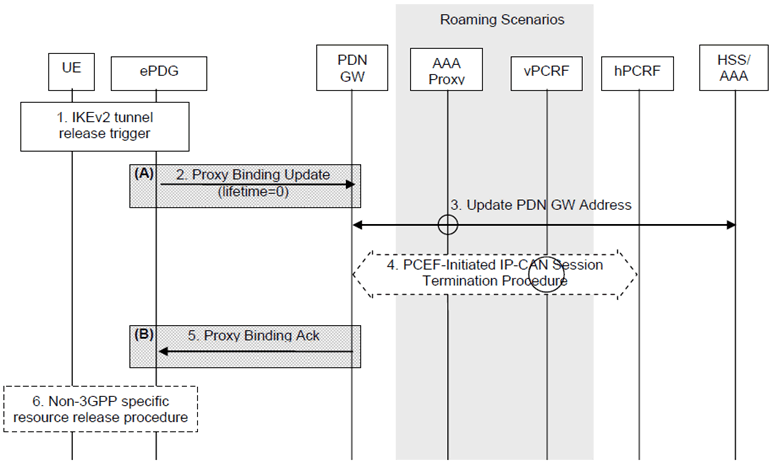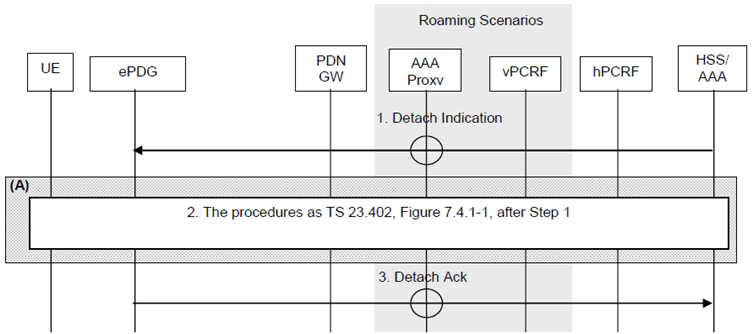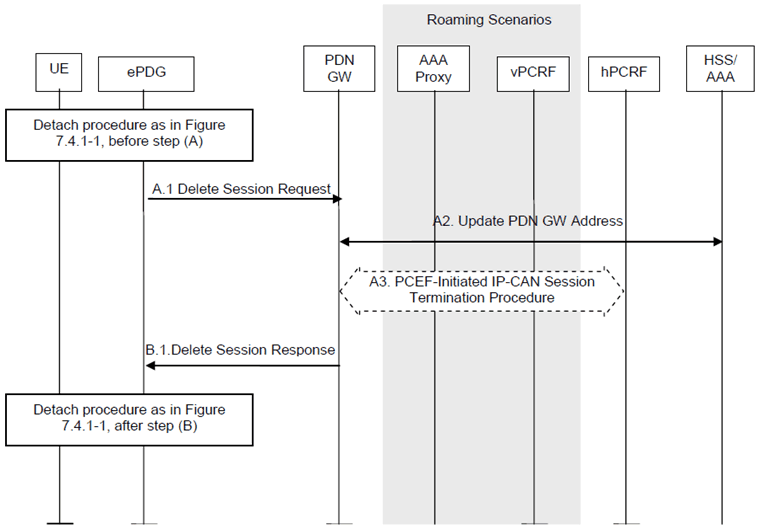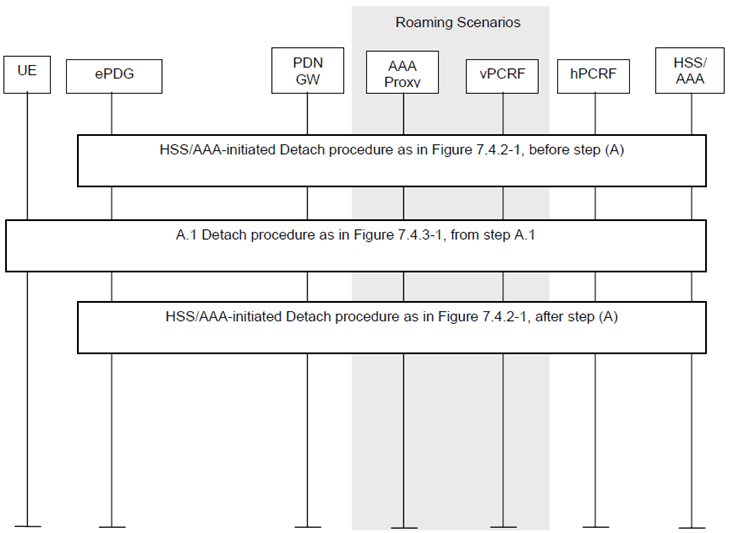Content for TS 23.402 Word version: 18.3.0
0…
4…
4.2…
4.2.2
4.2.3
4.3…
4.4…
4.5…
4.5.7…
4.6…
4.7…
4.7.2…
4.8…
4.8.2a…
4.9…
5…
5.2…
5.4…
5.5
5.6…
5.7…
5.8…
6…
6.2…
6.3
6.4…
6.4.3…
6.5…
6.6…
6.7…
6.8…
6.10…
6.13…
6.15…
7…
7.2…
7.3
7.4…
7.5…
7.6…
7.8…
7.10…
8…
8.2.1.2
8.2.1.3…
8.2.2
8.2.3…
8.2.6…
8.3…
8.4…
8.5…
9…
9.3…
9.4…
10…
13…
16…
16.1.2…
16.1.6…
16.2…
16.2.1a…
16.3…
16.4…
16.7…
16.8…
16.10…
17…
A…
C…
E…
7.4 Detach and PDN Disconnection for S2b
7.4.1 UE/ePDG-initiated Detach Procedure and UE-Requested PDN Disconnection with PMIPv6 on S2b
7.4.2 HSS/AAA-initiated Detach Procedure with PMIPv6 on S2b
7.4.3 UE/ePDG-initiated Detach Procedure and UE-Requested PDN Disconnection with GTP on S2b
7.4.4 HSS/AAA-initiated Detach Procedure with GTP on S2b
...
...
7.4 Detach and PDN Disconnection for S2b p. 167
7.4.1 UE/ePDG-initiated Detach Procedure and UE-Requested PDN Disconnection with PMIPv6 on S2b p. 167
7.4.1.1 Non-Roaming, Home Routed Roaming and Local Breakout Case p. 167
The procedure in this clause applies to Detach Procedures, initiated by UE or ePDG initiated detach procedure, and to the UE-requested PDN disconnection procedure when PMIPv6 is used on the S2b interface.
The UE can initiate the Detach procedure, e.g. when the UE is power off. The ePDG should initiate the Detach procedure due to administration reason or the IKEv2 tunnel releasing, when the ePDG should initiate the Detach procedure is implementation specific based on local operator policies.
For multiple PDN connectivity, this detach procedure shall be repeated for each PDN connected.

Figure 7.4.1-1: UE/ePDG-initiated detach procedure with PMIPv6 on S2b
(⇒ copy of original 3GPP image)
(⇒ copy of original 3GPP image)
The home routed roaming (Figure 4.2.3-1), LBO (Figure 4.2.3-4) and non-roaming (Figure 4.2.2-1) scenarios are depicted in the figure. In the LBO case, the 3GPP AAA Proxy acts as an intermediary, forwarding messages from the 3GPP AAA Server in the HPLMN to the PDN-GW in the VPLMN and visa versa. Messages between the PDN-GW in the VPLMN and the hPCRF in the HPLMN are forwarded by the vPCRF in the VPLMN. In the non-roaming case, the vPCRF and the 3GPP AAA Proxy are not involved.
If dynamic policy provisioning is not deployed, the optional step 4 does not occur. Instead, the PDN-GW may employ static configured policies.
Step 1.
IKEv2 tunnel release triggers PMIP tunnel release.
Step 2.
The MAG in the ePDG should send a Proxy Binding Update (MN NAI, APN, lifetime=0) message to the PDN-GW. When the MAG in the ePDG should send a Proxy Binding Update message to the PDN-GW is implementation specific based on local operator policies. The MN NAI identifies the UE. When only one PDN connection to the given APN is allowed the APN is needed in order to determine which PDN to deregister the UE from, as some PDN-GWs may support multiple PDNs. When multiple PDN connections to the given APN are supported, the APN and the PDN connection identity are needed in order to determine which PDN to deregister the UE from. The lifetime value set to zero, indicates this is a PMIP de-registration.
Step 3.
The PDN-GW informs the 3GPP AAA Server of the PDN disconnection. If the UE no longer has any context in the 3GPP AAA Server, the 3GPP AAA Server notifies the HSS as described in clause 12.1.2.
Step 4.
The PDN-GW deletes the IP-CAN session associated with the UE and executes a PCEF-Initiated IP-CAN Session Termination Procedure with the PCRF as specified in TS 23.203.
Step 5.
The PDN-GW deletes all existing entries for the indicated HoA from its Binding Cache and sends a Proxy Binding Ack (MN NAI, lifetime=0) message to the MAG in the ePDG. The PDN-GW sends a Proxy Binding Ack message to the ePDG. The MN NAI value and the lifetime=0 values indicate that the UE has been successfully deregistered.
Step 6.
Non-3GPP specific resource release procedure is executed.
7.4.1.2 Chained PMIP-based S8-S2b Roaming Case p. 169
This procedure is described in clause 6.4.1.2.
7.4.2 HSS/AAA-initiated Detach Procedure with PMIPv6 on S2b p. 169
7.4.2.1 Non-Roaming, Home Routed Roaming and Local Breakout Case p. 169
HSS/AAA-initiated detach procedure when PMIPv6 is used on the S2b interface is illustrated in Figure 7.4.2-1. The HSS can initiate the procedure e.g. when the user's subscription is removed. The 3GPP AAA Server can initiate the procedure, e.g. instruction from O&M, timer for re-authentication/re-authorization expired.
If the HSS/AAA-initiated detach procedure has been initiated to delete the UE from the Evolved Packet Core, the HSS/AAA server shall initiate the detach procedure for each of the access systems to which the UE is registered.

Figure 7.4.2-1: HSS/AAA-initiated detach procedure with PMIPv6 on S2b
(⇒ copy of original 3GPP image)
(⇒ copy of original 3GPP image)
Step 1.
The HSS/AAA sends a detach indication message to the ePDG to detach a specific UE.
Step 2.
This include the procedure after step1 as Figure 7.4.1-1.
For multiple PDN connectivity, this step shall be repeated for each PDN connected.
Step 3.
The ePDG sends a Detach Ack message to the 3GPP AAA Server. If the detach procedure was initiated from the 3GPP AAA Server and if the UE no longer has any context in the 3GPP AAA Server, the 3GPP AAA Server notifies the HSS as described in clause 12.1.2. If the detach procedure was initiated by HSS, the 3GPP AAA Server replies to the HSS as described in clause 12.1.3.
7.4.2.2 Chained PMIP-based S8-S2b Roaming Case p. 170
This procedure is described in clause 6.4.2.2.
7.4.3 UE/ePDG-initiated Detach Procedure and UE-Requested PDN Disconnection with GTP on S2b |R10| p. 170
7.4.3.1 Non-Roaming, Home Routed Roaming and Local Breakout Case p. 170
This clause describes the UE-requested PDN disconnection procedure when GTP is used on the S2b interface.
The UE can initiate the Detach procedure, e.g. when the UE is power off. The ePDG should initiate the Detach procedure due to administration reason or the IKEv2 tunnel releasing. When the ePDG initiates the Detach procedure is implementation specific based on local operator policies.
For multiple PDN connectivity, this detach procedure shall be repeated for each PDN connected.

The home routed roaming (Figure 4.2.3-1), LBO (Figure 4.2.3-4) and non-roaming (Figure 4.2.2-1) scenarios are supported as specified in clause 7.4.1.
Step A.1.
The ePDG should release this particular PDN connection and should send a Delete Session Request (Linked EPS Bearer ID, UWAN Release Cause if available, User Location Information) message for this PDN connection to the PDN-GW. When the ePDG should release this particular PDN connection and should send a Delete Session Request is implementation specific based on local operator policies. UWAN Release Cause is only sent by the ePDG to the PDN-GW if this is permitted according to ePDG operator's policy.
The User Location Information shall include UE local IP address and optionally UDP or TCP source port number (if NAT is detected). It may also include WLAN Location Information (and its Age) the ePDG may have received from the 3GPP AAA server about the UE. When the PDN-GW receives no WLAN Location Information from the ePDG it shall delete any such information it may have stored for the PDN connection.
Step A.2.
Same as step 3 of clause 7.4.1.1.
Step A.3.
The PDN-GW deletes the IP-CAN session associated with the UE and executes a PCEF-Initiated IP-CAN Session Termination Procedure with the PCRF as specified in TS 23.203. If received from the ePDG, the PDN-GW shall also forward the UWAN Release Cause, and PCRF shall forward it to the Application Function as specified in TS 23.203. If requested by the PCRF, the PDN-GW forwards to the PCRF following information extracted from User Location Information it may have received from the ePDG:
Step B.1.
- WLAN location information in conjunction with the Age of this information,
- The UE local IP address and optionally UDP or TCP source port number (if NAT is detected).
The PDN-GW acknowledges with a Delete Session Response (Cause) message.
7.4.4 HSS/AAA-initiated Detach Procedure with GTP on S2b |R10| p. 171
7.4.4.1 Non-Roaming, Home Routed Roaming and Local Breakout Case p. 171
HSS/AAA-initiated detach procedure when GTP is used on the S2b interface is illustrated in Figure 7.4.4-1. The HSS can initiate the procedure e.g. when the user's subscription is removed. The 3GPP AAA Server can initiate the procedure, e.g. instruction from O&M, timer for re-authentication/re-authorization expired.
If the HSS/AAA-initiated detach procedure has been initiated to delete the UE from the Evolved Packet Core, the HSS/AAA server shall initiate the detach procedure for each of the access systems to which the UE is registered.

Step A.1.
For multiple PDN connectivity, this step shall be repeated for each PDN connected. This step does not apply to a PDN connection set-up for emergency services.